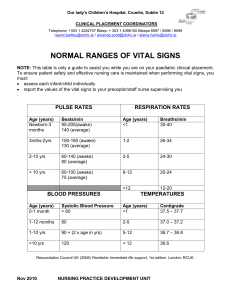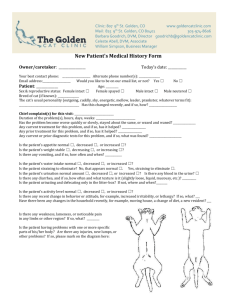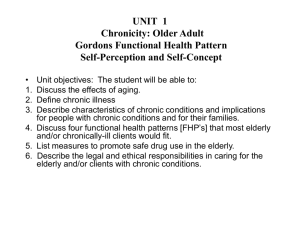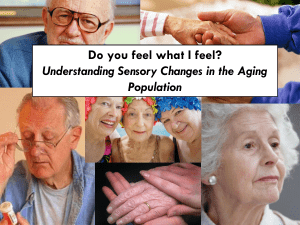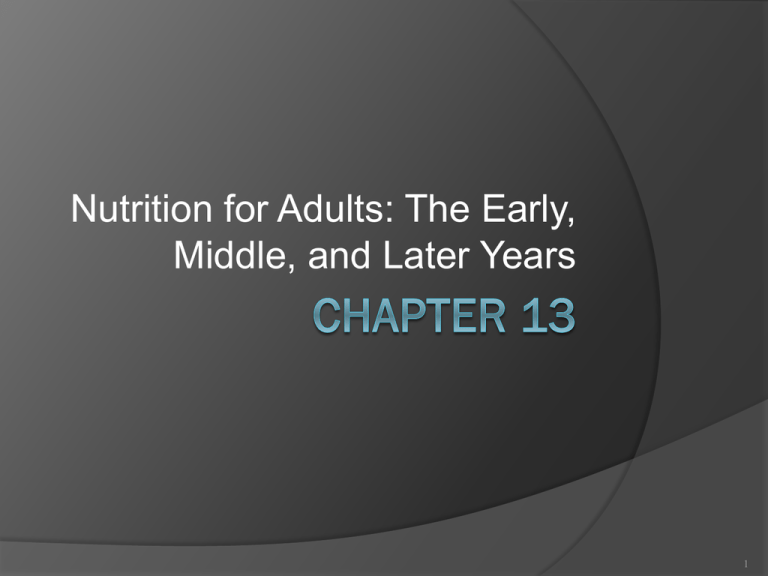
Nutrition for Adults: The Early,
Middle, and Later Years
1
Population Facts
By 2030 the U.S. population will grow to 363
million, up 29.2% from the year 2000.
Life expectancy = 78 yrs by 2010
74 yrs men, 81 yrs women
1900 = 49 yrs
Life expectancy varies by group and income
Women outlive men - average 6 yrs
2
Influences on Growth of Adults
Physical maturity
Reached in late teen years
Levels off in early adult years
Age groups
Young adults (18 to 39 years)
Identity, Intimacy (Erikson)
Middle adults (40 to 64 years)
Some sources = 40-70
Generativity
Older adults (65 years and older)
Integrity
3
Young Adults
Lifestyle choices made now are very
important for maintaining “quality of life”
○ Physical exercise
○ Healthy food choices
○ Balanced meals
4
Middle Adults
early signs of chronic disease may start
to appear now
Diabetes
Heart disease, etc.
**wellness and health promotion to reduce risk
of disease are major focus of health care !!!
5
Older Adults
Kilocalories recommended:
Metabolic demands are decreased
Ages 51-70 = 2000 - 2500 cal/day
Older than 71 = 1500 – 2200 cal/day
Carbohydrates
50-60% total calories
Minimum of 130 gm carb per day to maintain
healthy brain function for all age groups
6
Older Adults
Fats
30% (20-35%) total calories, backup energy
Avoid large quantities of fat
Fat digestion/absorption delayed
Proteins
Adult need = 0.8 g/kg (or up to 1.3 g/kg)
○ To prevent loss of muscle mass
Average 50 gm per day
Need for protein may increase during illness and
convalescence
7
Older Adults
Vitamins & Minerals
Vit. D and calcium essential to prevent &
treat osteoporosis
Iron may be needed to treat iron-deficiency
anemia
Vit. B12 recommended for adults over age
50, older adults have decreased absorption
of B12
○ usually given as an injection
8
Aging Process and Nutrition
Needs
Effects on food patterns
Diminished secretion of digestive enzymes
and motility of GI muscles causes
decreased absorption and use of nutrients
Decreased taste, smell, and vision affect
appetite
Higher calorie meal served at breakfast
○ To reduce GI effects at bedtime
9
Clinical Needs
Undernourishment risks:
Low appetite
Loneliness
Lack of money
Dental problems, tooth loss
Gastrointestinal problems, decreased
secretions, decreased taste
Dehydration, reduced thirst sensation
.
10
Assisted Feeding
Make no negative remarks about food
being served.
Identify the food being served.
Allow at least three bites of each item
before serving the next food.
Allow time to chew and swallow.
Give liquids throughout meal.
***allow pt. to self-feed if possible
11
Benefits of Physical Activity for
Senior Adults
Maintain independence
Reduce blood pressure
Improve stamina, muscle strength for those
with chronic conditions
Reduce anxiety, depression symptoms
Healthy bones, muscles, joints
Control joint swelling and pain of arthritis
30 minutes/day (1-3 sessions)
Copyright © 2009, by Mosby, Inc. an affiliate of
Elsevier, Inc. All rights reserved.
12
Chronic Diseases of Aging
Heart disease
Cancer
Arthritis
Diabetes
Alzheimer’s disease
Renal disease
13
CDC Recommendations to
Prevent Chronic Disease
Stop smoking
Limit alcohol intake
Be physically active
Maintain healthy weight
Diet low in fat and cholesterol
14


